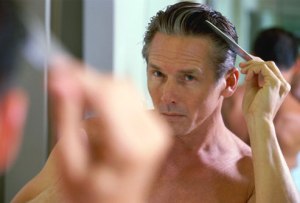The mirror, in all its exactitude, remains the chief enemy of a healthy body image. Filtered through layers of expectation, desire, ambition, and societal pressure to conform to a one-size-fits-few mold, the reflection reads like failure to many. The effect is so strong that when a typical distraught mirror-gazer huffs and leaves the mirror, dresses for the day, and hears a friend say, “You look great,” the hearer’s first inclination is to disbelieve the sincere compliment.
What seems like errors in vanity are really evidence of a true psychic problem in society. Plenty of evidence supports the sad conclusion, particularly where young girls are concerned. But as the father of a son, I see the insidious process at work on my boy as well (albeit less severely than in girls). And we all know that a great many adults never escape this mania. We know because we daily meet that enemy, and it is us.
It is pretty much accepted as a nutritional axiom nowadays, requiring no further proof, that despite our national obsession with weight loss, the United States is the most obese industrialized nation in the world. (I know there may well be some small island-state with a higher per capita number, but among the big ones, we’re the biggest.) I don’t say this with the accusatory finger-wagging that some commentators employ. Nor do I believe, as one Facebook poster implied some months ago, that all 314 million of us are — how did she put it? — “fat, drugged, obsessed and sad.” No, I offer my observation more in the spirit of empathy. Having been there — having paid rent there, even when absent — I know what it’s like.
My Slavic body type tends toward beefiness, even in its best condition. We joke in my family that it’s a good thing my paternal grandfather was a cooper; when stock ran low, we could sell our barrel chests. Willowy is not in our vocabulary; lanky is right out. Add to that a natural affinity for food and cooking, a genetic taste for high-fat Jewish cuisine, and the advent of modern processed foods, and corpulence is the only possible end to the equation.
Or is it? I have been fighting my weight half my life, with varying degrees of success. Never is there a straight line to the promised land. I have learned not to toss my “fat clothes” too soon. Humility is part of the process. But more important, I have demoted the mirror to its proper place in the evaluative hierarchy.
What do I mean by this? Well, I know that at 52, no matter how well I do, the days of washboard — or even completely flat — abdominal muscles are probably gone. There is no question, though, that when I pay proper, sustained attention to diet and exercise, there are nicer things to see in the mirror. But perfection? Nope. Being my own harshest critic, I will always be able to find something that could be better. Some things are convex that I would rather see concave, if you get my drift. Biceps will become stronger and more defined, but they have a more casual relationship with their moorings than they did 30 years ago. So it goes. (My legs are exempt from criticism, though. They’re great. Ask my wife.)
Kidding aside, there has to be a change in perspective if one is to enjoy the success and minimize the imperfections. I’ll help you shortcut right to it: it’s how you feel. I had a coach who, in teaching an athletic motion to me (never an easy task), said in that rhyming way of coaches, “A.B.; your feel ain’t real.” That is, what I felt I was doing in swinging the bat wasn’t what I was actually doing.
Not true for evaluating the results of exercise and proper diet. Your feel is most real. Surely you have noticed, when you exercise and get past any initial-stage discomfort, that you feel like a million bucks. Canadian. You seem to stand up straighter with no extra effort. Your attitude is sunnier. Problems don’t stick to you as easily. You sleep better. And on and on.
Our self-images are so sludged up with societal crap and negative self-talk that I’m not sure any of us know how we really look. By focusing on how good you feel, that matters less. And when you feel good, very often the looking good takes care of itself.♦
© 2013 Adam Barr


